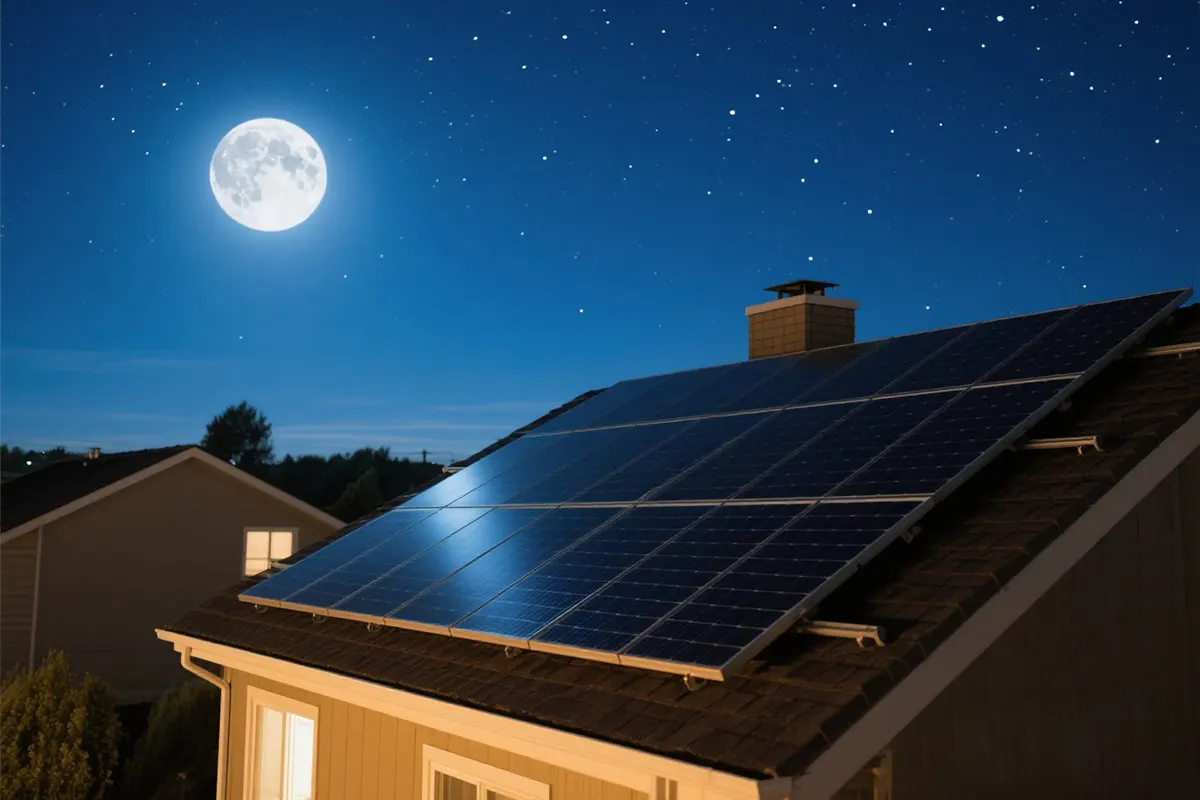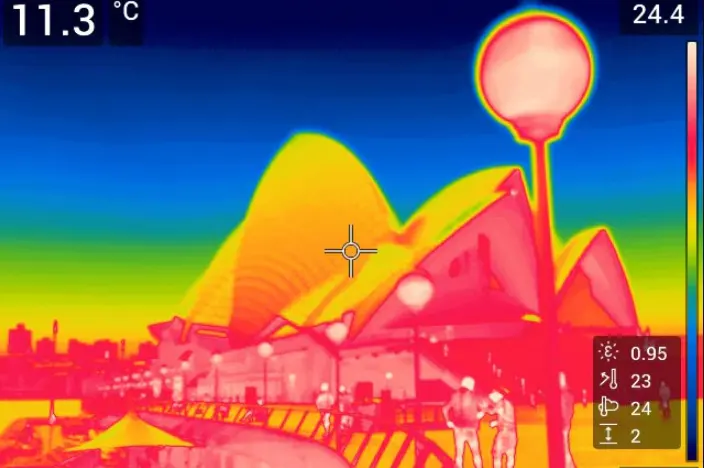June 6, 2025
Do solar panels work at night?
Solar energy is one of the most environmentally friendly and relatively stable energy sources on Earth, but it has a significant shortcoming: it “stops working” after sunset at night, and humans can no longer harness its energy. Yet, nighttime is precisely when energy usage peaks — lighting, heating, cooling, and more.
In this post, we’ll explore why solar panels cannot work at night, how to fully utilize the limited daytime window of solar power for nighttime needs, and whether there are any alternative nighttime power generation technologies.
1. Solar panels cannot work at night
When sunlight hits a solar panel, it triggers a phenomenon known as the photovoltaic effect. The sunlight excites electrons in semiconductor materials, giving them enough energy to jump from the valence band to the conduction band, creating electron-hole pairs. Under the influence of an electric field, these electrons and holes are separated, producing an electric current.
Moonlight, on the other hand, is actually sunlight reflected off the moon’s surface. At night, even if there is moonlight containing some visible and ultraviolet light, it can theoretically trigger a photovoltaic effect.

Interestingly, moonlight’s illumination intensity is only about 0.0002%–0.00003% of sunlight’s intensity—far too weak. Even if solar panels generate a tiny amount of current under moonlight, the voltage is usually far below the inverter’s startup voltage (the core device that converts DC to AC in solar systems). If the inverter can’t even start, there’s no way to generate usable electricity.
2. How to maximize solar energy utilization
Match usage to peak generation hours
Residential solar systems typically generate the most power between 11 a.m and 2 p.m. According to data from the International Energy Agency (IEA 2023 report), if homeowners shift energy-intensive activities (like laundry or water heating) to these hours, they can boost their self-consumption rate from 40% to over 70%.
Smart appliance scheduling
Using smart appliances (like programmable water heaters, storage air conditioners) or smart plugs to operate automatically during peak solar generation can significantly reduce grid electricity usage. According to an NREL report, smart home control can further increase the self-consumption rate by 10%–20%.
Of course, all of this assumes favorable household conditions—otherwise, a sufficiently large battery is essential.
Configure a storage system
If there’s no battery, the electricity generated by solar panels during the day will automatically be fed into the grid, earning some compensation. However, with a battery installed, the stored electricity can be used as backup, ensuring no worries about power shortages or high electricity rates at night.
Studies and real-world cases show that a 5–10 kWh storage system paired with a 4–6 kWp photovoltaic system can boost solar self-consumption from 40%–60% to over 90%. This means surplus daytime solar power is efficiently stored and used at night, significantly reducing dependence on the grid.
How to match battery capacity to household needs?
For a home with an annual electricity consumption of 2,500–3,500 kWh: usually, a 5–10 kWh storage system is suitable.
Summer scenario: With ample sunlight and high PV output, the battery typically charges fully between 6–10 a.m and gradually discharges 30%–50% at night to meet peak household demands like cooking and lighting.
Winter scenario: Although PV generation is lower, the battery can still store some daytime energy to partially cover nighttime needs and reduce peak-hour electricity costs.
3. New “nighttime power generation” technologies?
In 2022, a team from the University of New South Wales published innovative research showing that even after sunset, Earth’s radiative infrared heat can be harnessed to generate electricity.

The core of this technology is the thermoradiative diode—a semiconductor device similar to the materials used in night vision devices.
How it works
Daytime: The sun heats the Earth, and the ground absorbs this energy.
Nighttime: Earth releases heat to the cold of space through infrared radiation.
Energy conversion: The thermoradiative diode converts this infrared radiation into electricity, enabling power generation even in the absence of sunlight.
As Dr. Phoebe Pearce of the research team stated: “Just as solar cells generate power by absorbing sunlight from a hotter sun, thermoradiative diodes generate power by emitting infrared light to a colder environment. In both cases, the temperature difference is the key to power generation.”
Although output remains minimal so far, this marks a significant first step in feasible“nighttime solar” power generation and proves that thermoradiative diode-based power generation is viable. With further research and technological advancements, thermal radiation power generation holds promise for practical applications in multiple fields.
Beyond thermoradiative diode technology, there are also studies and technologies like Stanford University’s nighttime radiative cooling power generation and nighttime thermophotovoltaic power generation, which are likely to enter our daily lives in the near future.
4. Rapid growth of PV + storage
According to the IEA’s June 2025 report, global energy investments are expected to reach a record-breaking $3.3 trillion. Of this, investments in clean energy technologies (including renewables, nuclear, and storage) will total $2.2 trillion—double the investment in fossil fuels.
Government incentives and policy support
Australian state governments have introduced several battery subsidy programs to encourage household and business users to install storage systems. For example, Queensland has launched the “Battery Booster” program, offering up to AU$4,000 in residential battery subsidies. Similarly, New South Wales, Victoria, and the Northern Territory have also launched related incentive programs.
In 2023, the EU adopted a revised Renewable Energy Directive, raising its 2030 renewable energy target from 32% to at least 42.5%, with the ambition to reach 45%. To meet this goal, the EU launched the “REPowerEU”plan, aiming to double solar PV capacity by 2025 and reach 600GW by 2030.
5. FAQ
What to do when solar panels can’t generate electricity at night?
During peak daytime solar generation, try to concentrate the use of household appliances (like washing machines, water heaters, and air conditioners) to directly consume more solar power.
For nighttime electricity shortfalls, households usually install storage batteries (5–10 kWh is common), which store surplus daytime solar energy for use at night—significantly boosting self-consumption to over 90%.
After installing a storage battery, will the house no longer need the grid?
Storage batteries can significantly reduce dependence on grid electricity, but to go completely “off-grid,” a larger storage capacity (>10 kWh) and an appropriately sized solar PV system are needed. Additionally, during winter when sunlight is limited and PV generation is lower, some grid power will still be needed.
How long does a home storage battery last? What’s its lifespan?
Lithium storage batteries typically have a cycle lifespan of 3,000–6,000 cycles, translating to roughly 10–15 years of usage. Actual lifespan also depends on daily depth of use, thermal management, and other conditions.
When do solar panels stop working?
Solar panels stop generating electricity when the ambient light drops below a certain threshold (typically at sunset or at night), and current generation falls to nearly zero.
On cloudy or overcast days, sunlight intensity decreases, and solar panel output also declines, but it typically doesn’t stop completely. As long as there’s enough light, some generation continues.
6. Conclusion: Nighttime electricity relies on “daytime storage”
While current solar panels can’t rely on moonlight or starlight to generate electricity at night and remain bound by the cycle of sunrise and sunset, storage battery technology and smart scheduling can extend solar power from daytime to nighttime.
Nighttime power generation technologies (like thermoradiative diodes and nighttime thermophotovoltaics) are still in the experimental stage, but as technology progresses, we may see truly viable “nighttime solar” in the future.
share
